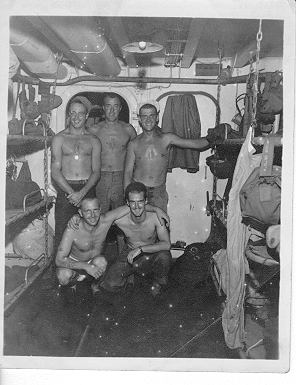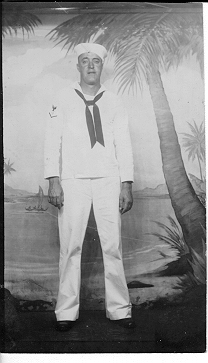 In May, 1943, George joined the US Navy to help fight the Japanese in the Pacific. Being a skilled laborer and over the age of 30, he was assigned to the Sea Bees, a subset of the Navy that focused on construction. Called the “Naval Construction Force”, the Sea Bees’ motto was “We Build, We Fight“.
In May, 1943, George joined the US Navy to help fight the Japanese in the Pacific. Being a skilled laborer and over the age of 30, he was assigned to the Sea Bees, a subset of the Navy that focused on construction. Called the “Naval Construction Force”, the Sea Bees’ motto was “We Build, We Fight“.
In December, 1943, George was assigned to Detachment CBD-1039 of the 102nd Naval Construction Battalion (NCB), then merged into the the 302nd NCB in 1944, stationed in Pearl Harbor, Hawaii. His unit took part in a number of Pacific island forward combat campaigns, including the Marshall and Mariana Islands, Peleliu, Leyte, Anguar, Tinian, Luzon, and Okinawa.
George’s detachment built “pontoon causeways”, floating barge/runways that were used to transport troops, equipment and supplies from naval landing ships (LSTs) onto the islands. These causeways were necessary because coral reefs prevented ships from coming in close to the island. They also delivered fuel and equipment among the vessels positioned outside the island harbors.

These photos show George in the Navy during World War II. In the left photo, he is standing in the middle. In the center photo, he is on the right.
George received a Purple Heart for wounds received on Roi Island (Marshalls) on February 12, 1944, awarded on March 20, 1945. According to the award letter, George was shot in the hand and received wounds to the back. According to George’s close friend, Claude Quigley, he was wounded by a White Phosphorous (WP) munition. George was said to have mailed the award home soon after receipt and a newspaper story was printed showing his wife Loretta pinning the medal on her youngest’s shirt. This child was Richard Patrick Flaherty, 10 months old, born while George was away in the Pacific. The article was from the Boston Daily Record, probably between March 20 and May 20, 1945.
Claude Quigley also received a Purple Heart that day. “Quiggy” was from Rumford, Maine and became a close friend of George during the war. After the war, George and Loretta would visit him in Rumford every few years. I connected with Claude in October 1997, living in St. Petersburg, Florida and he sent me his copy of the 302nd NCB “cruise book”, similar to a high school yearbook, with photos and stories of the unit’s campaigns. I gave this book to Joe Flaherty, who donated it to the Seabee Museum in Davisville Rhode Island. Thanks to Joe, you can purchase a digital copy of this book on CD through the museum.
In addition, a complete history of the 302nd NB can be found in this PDF document.
George was discharged from service on 29 September, 1945 as a Ship Fitter 2nd Class (SF2c/Petty Officer 2nd Class) not long after the Japanese surrendered in Tokyo Bay on the USS Missouri, September 2, 1945.

Every day, I think about the story of Homer and Minnie and how their paths crossed, eventually resulting in the birth of George, his participation in saving the world from fascism and the creation of a large family that is now spread all over this great United States.
Coming soon…the family that George and Loretta created…


